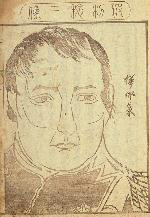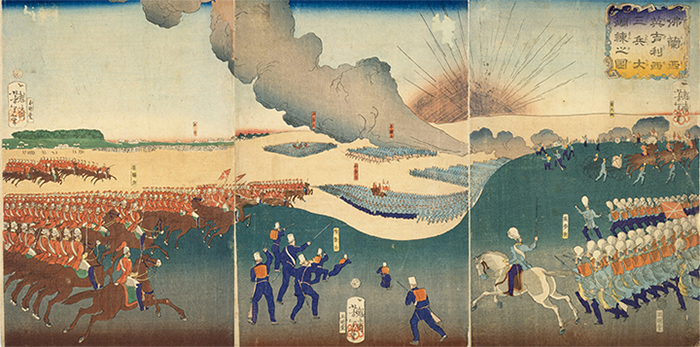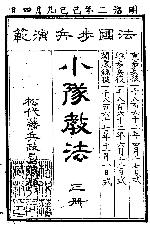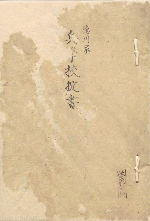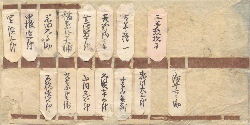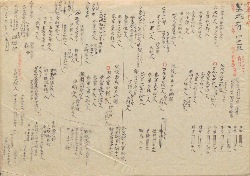![]()
Section 2: French military advisers and military modernization
Even during the Edo Period, when information about other countries was rare, there were still some known traces of Napoléon Bonaparte (1769-1821) and poems and translated biographies about him were written.
The impact of the Black Ships led to the Shogunate government seeking to strengthen its military might, with a reform of the military system at the end of the Tokugawa Shogunate government. In 1865, SHIBATA Takenaka (1823-1877), through negotiations, the director-general of the Ministry of Foreign Affairs who was dispatched to France and England, invited military advisers from France, and worked to introduce a French-style military. This can be said to be an example of France planning to build closer relationships with the Shogunate government in opposition to Britain, who has come to support the Satsuma Domain after the Kagoshima Bombardment.
After the Restoration of Imperial Rule, the majority of the individuals who possessed military and Western studies knowledge from the previous Shogunate government followed the Tokugawa Clan in relocating to the Shizuoka Domain, and opened a military school in Numazu. This later became part of the Military Academy, and the army in particularly was strongly influenced by France after the Meiji Restoration, with military advisers being invited from France by the Meiji government and other measures.
Johannes van der Linden, KOSEKI San’ei (Tr.), Naporeon bonaparute den, Matsuokashiseifukan, 1857 [W346-18] 
The biography of Napoléon Bonaparte had already been translated since the Edo Period. News of the outbreak of the French Revolution quickly reached Japan in information from overseas (Fūsetsugaki) on a ship from the Netherlands in 1794 and in 1818, RAI San'yo (1780-1832) composed the Chinese-style poem Futsurō ōka about Napoléon. The translator of this text, KOSEKI San'ei (1787-1839), was born in Shonai, Dewa no Kuni (present day Yamagata Prefecture). After persuing Chinese studies, he went to Edo and began learning Dutch studies. He was appointed as a member of the staff of the translation department of the Shogunate Astronomical Observatory and worked translating Dutch, however in 1839, he was faced with the Bansha no goku suppression of scholars of western studies and committed suicide. This is thought to be a translation of a text by Johannes van der Linden (1756-1835) obtained by San'ei in 1832, however it wasn't published until 1857 after his death. Works and translations related to Napoléon were not rare even from the Meiji Era onward.
Ikkaisai Yoshitoshi, Furansu igirisu sanhei ō chōren no zu, Gyokumeido, 1868 [寄別7-5-1-1] 
TSUKIOKA Yoshitoshi (1839-1892) was an artist who was known as "the last ukiyo-e artist". He was born in 1839 in Edo, and he became a disciple of UTAGAWA Kuniyoshi (1798-1861) at the age of 12 years old. He became independent at the age of 21, and before long rose to the top of the ukiyo-e artists' ranking, leading to him gaining a large number of disciples. EDOGAWA Rampo (1894-1965) and MISHIMA Yukio (1925-1970) were partial to his bloody and grotesque images, and he was also famous for erotic and fantastical images. It is not sure if this image was an actual view or not, but it displays a vivid image of the British and French militaries which were stationed in Japan at the end of the Tokugawa Shogunate government. The scene depicts the British and French militaries which were stationed in Yamate, Yokohama from 1863 onward in order to protect their countrymen from attacks on foreigners after the occurrence of the Richardson Affair. The "Sanhei" (three armies) in the title refers to the cavalry, infantry and artillery troops.
(Tr. Matsushirohan Gakuseikyoku), Hōkoku hohei enpan shōtai senpō, Matsushirohan Heiseikyoku, 1869 [特39-893] 
In 1866, the Edo Shogunate concluded an agreement to bring in military advisers from France, and in December of the same year, 20 advisers arrived under Captain Charles Sulpice Jules Chanoine (1835-1915) (the 1st adviser group). At the same time as the Shogunate government's military reforms, French style manuals were translated, and this text was translated by the Matsushiro Domain which utilized a French style military system.
The 1st adviser group was discontinued after the former Shogunate government military lost the Battle of Toba-Fushimi and returned to their country. In 1872, the Meiji government imitated the Shogunate government and assembled the 2nd adviser group, and this group of over 20 advisers participated in the founding of the Military Academy, however after Major Klemens Wilhelm Jakob Meckel (1842-1906) was brought in as an adviser from Germany in 1885, Japan's army began to be more strongly influenced by Germany.
Tokugawake heigakkō okitegaki [Papers of AKAMATSU Noriyoshi, #51] 
During the last days of the Tokugawa shogunate, the Shogunate government reformed its military system modeled on France, and after the Restoration of Imperial Rule, a large number of the former vassals of the Shogun who relocated to the Shizuoka Domain carried that knowledge with them and established military schools. Many of the individuals previously belonging to the former shogunate Department of the Army relocated to Numazu, and a military school was also established in Numazu under the leadership of EBARA Soroku (1842-1922) and others. These materials are published rules established in December of 1869 with the establishment of the Numazu military school. The rules were mainly created by AKAMATSU Noriyoshi (1841-1920) and NISHI Amane (1829-1897), who had studied abroad in the Netherlands during the last days of the Tokugawa shogunate, and include a total of 85 rules as well as faculty office and classroom notices. In addition to items related to students, such as entrance credentials and entrance tests, sick days, etc., details on the handling of instructors is included in the same set of rules, providing an overall view of the operation of the military school. English or French could be selected for language studies, with aims to cultivate officers in a French style military system for the army in particular.
Numazu heigakkō meibo [Papers of AKAMATSU Noriyoshi, #52] 
This is a list of names from the Numazu military school which was left by AKAMATSU in 1869. There are also traces of missing sections, so a complete picture of the military school cannot be obtained simply from these materials, however it does provide knowledge of the names of many of the individuals related to the Numazu military school. The instructors included AKAMATSU, NISHI and those who studied in Netherlands, Shogunate government military graduates, Kaisei-jo graduates, and others, and the school provided superior educational content. In addition, a Numazu military school affiliated elementary school was also established, which is said to have been a predecessor for modern elementary schools due to its group teaching system and allowing enrollment of common people. Control of the Numazu military school was transferred to the Ministry of Defence after the establishment of prefectures in place of feudal domains in September of 1871, and became one of the origins of the Military Academy.
Seinufu Pari sonota (Futsukoku gunsei) [Papers of NISHI Amane, #96] 
After working as the head of the Numazu military school, NISHI, who had learned Dutch studies in the last days of the Tokugawa shogunate and translated the International Law (lectured by Simon Vissering) [W358-41], worked as an educator including providing general lectures on Hyakugaku renkan (lit. Encyclopedia) related to academic systems at private schools. He also played an important role in the founding of the Meiji government military. On the recommendation of KATSU Kaishu (1823-1899), NISHI served the Ministry of Defence and Ministry of the Army and worked as an adviser to YAMAGATA Aritomo (1838-1922) and participated in the preparation of the military system, such as by participating in the drafting of the Imperial Rescript to Soldiers and Sailors and establishment of the Conscription Law issued in January of 1973. These materials are thought to be a survey of the French military system when planning the size of the military after the enactment of the Conscription Law, and note the number of troops in military units stationed in various areas including Paris.

